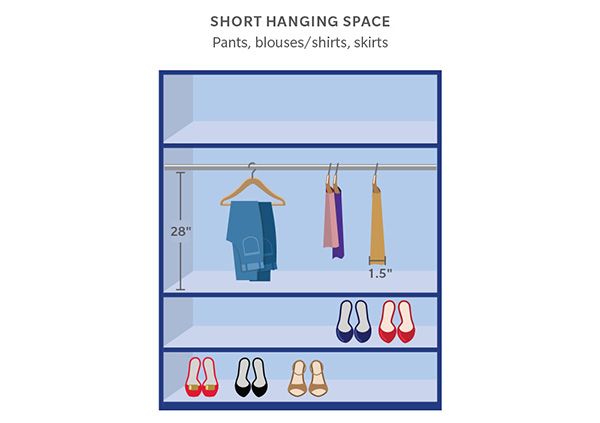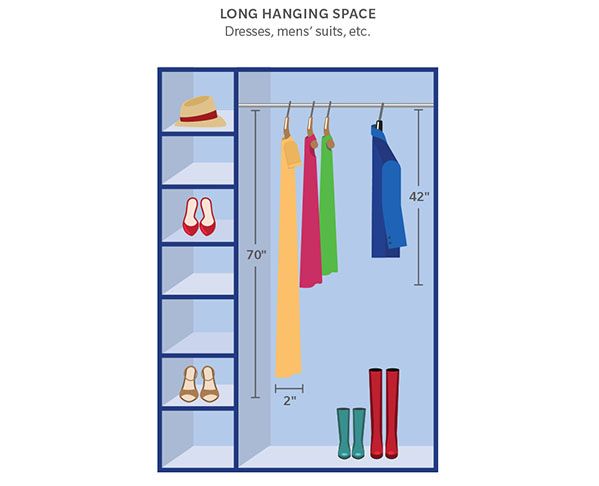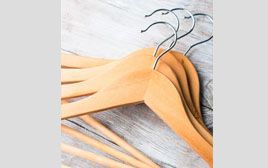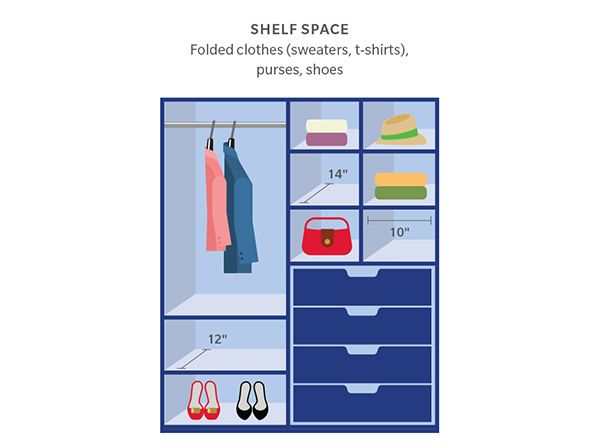Soon after Timisha Porcher moved into her Maryland home, she went on a mission to remodel the master bedroom's closet, which had been painted bright orange. That was the least of the closet’s problems. Hanging rods and shelves were loose or missing, and as a result, Porcher had to leave most of her wardrobe folded and stacked in the master bathroom’s tub.
So, she plotted a closet makeover on graph paper and spent $400 and two weekends installing everything.
"The finished, empty closet was gorgeous," says Porcher.
But there was one fatal flaw. Despite thorough measuring and planning, Porcher forgot to take a ruler to the most important part of the closet: her clothes. "The hanging clothes are too long and they cover the drawers of the closet's existing built-in dresser," she says. "I still can't believe I missed that."
When remodeling a closet, little details like measuring your wardrobe can matter even more than the quality of the finishes, says Eric Marshall, a certified closet designer and board member of the Association of Closet and Storage Professionals (ACSP). That's why Marshall tries to start every project with a meeting inside the client's closet. He also asks clients not to organize or clean before the consultation. "I like to see the problems so I can fix them."
With an eye toward key technical and planning details, Marshall and other closet designers and DIYers outline their best advice for what to consider when remodeling a closet.
Short hanging space: pants, blouses/shirts, skirts

Measure twice, build once.
Porcher, a.k.a. ToolBox Diva, a DIY blogger, approached her closest project like a pro: with a graph paper notebook, tape measure and pencil. The first step in her closet renovation started with meticulous measurements of the closet space — floor to ceiling, wall to wall. Then, she drafted the new closet on four sheets of graph paper, with every square on a page representing six inches, to create a scaled outline of the closet’s measurements.
After measuring the closet space, Porcher realizes she should have taken a complete inventory of the wardrobe — including length and width measurements of hanging and folded clothing.
To ballpark the amount of horizontal hanging space needed in a closet, Marshall recommends multiplying the number of pieces by the following measurements. (For example, eight men’s suits require 20 inches (8 suits x 2.5 inches = 20 horizontal inches) of space on a hanging rod.
Suits: 2.5 inches
Dresses: 2 inches
Folded pants/skirts: 1.5 inches
Blouses: 1.25 inches
Vertical hanging space is equally important when planning the layout of a hanging system and shelving. Start the design with one hanging rod that leaves a 70-inch clearance for long coats and dresses, which are typically 60-plus inches long. Shirts and jackets — typically 36 inches for women’s and 38 inches for men’s — typically need 42 inches of vertical clearance. An additional rod can be installed underneath for folded pants and skirts, which need 28 inches of vertical hanging space. If the closet’s ceilings are 10 feet or higher, Marshall recommends a pneumatic pull-down rod, which can triple the amount of hanging space.
Long hanging space: dresses, men's suits, etc

Leave this much space for shelves.
As clothing needs change, shelves installed on an adjustable track — versus mounted on a fixed bracket — can be moved to accommodate more items. Once any shelving is installed, however, you can’t adjust the depth of the shelf, which should be 14 inches, according to Atlanta ACSP member and designer/builder David Buchsbaum. The standard measurement of folded clothes may vary according to the item, but 14 inches will cover a wide range without overhang. If your closet is five feet wide or less, hang clothes on one side and install shelves on the other. “This leaves about two feet to walk down the center,” he says.
Measure the tallest handbag, hat or other shelf item in your wardrobe and size the closet’s upper shelves to accommodate these pieces. Shelves at eye-level or below can hold sweaters (typically 10 inches wide when folded), purses and shoes (on a tilted 12-inch shoe shelf). Porcher recommends vertical dividers to keep bulky stacked sweaters from tilting or sliding; Marshall uses dividers to separate purses.

Choose the Right Hanger
Shelf space: folded clothes, purses, shoes

The material pros and DIYers prefer.
White melamine (particleboard encased in waterproof, scratch-resistant resin) is a wallet-friendly, long-lasting material, and clothes stand out against it, says Marshall.
Although coated wire shelving systems tend to be more popular (particularly among DIYers), California resident Janet Perry renovated her closet specifically to get rid of wire shelves and rods. She found hangers didn’t sit well on the thin rods, the wire shelves were too narrow, and the closet’s old system could not handle the weight of her clothes. A pre-fabricated white melamine closet system with rods and shelves averages $100 to $150 per linear foot. Perry and her husband installed their 6-by-12-foot walk-in master closet et over two weekends — including rods, shelves and drawers — for about $1,200.
“Hiring a pro to customize a walk-in could cost $5,000 to $20,000, depending on style and finish,” says Marshall. If these numbers seem high for a space to hold socks, data from the National Association of Realtors show that 60 percent of home buyers are willing to pay $1,350 more for a walk-in master closet. Manhattan real estate agent Julie Gans sold a one-bedroom for $710,000 on the strength of several tricked-out closets. “The minute we walked in, the buyer fell in love with the beautiful custom closets that slid, twirled and contorted to use every allowable space.”
These accessories keep closet space optimized and organized.
Two areas of potential wasted space in a closet: the middle section and corners. “I put a laundry basket on wheels in the middle so I can move it around,” says Porcher. In a closet corner, Buchsbaum installs a Lazy Susan shoe spinner, which costs about $400. More space-saving accessories:
Valet rods
These retractable hooks can be mounted at waist and neck height, allowing you to mix and match tops and bottoms to see what you want to wear, says Marshall.
Shoe bags
Porcher’s hanging closet shoe bags saved valuable floor space and helped organize grab-and-go items like gloves.
Lighting
Warm or neutral white flexible LED strip lights installed inside drawers or under shelving can cure issues with bleak single-bulb overhead lighting or dark corners, says Buchsbaum.
Valet rods
These retractable hooks can be mounted at waist and neck height, allowing you to mix and match tops and bottoms to see what you want to wear, says Marshall.
Shoe bags
Porcher’s hanging closet shoe bags saved valuable floor space and helped organize grab-and-go items like gloves.
Lighting
Warm or neutral white flexible LED strip lights installed inside drawers or under shelving can cure issues with bleak single-bulb overhead lighting or dark corners, says Buchsbaum.
DIY Tip
Porcher used a laser level to get hanging rods and clothing shelves perfectly straight. Once you find an initial height to hang a shelf, a laser level projects a red beam across the wall for easy and accurate measurement. Another electronic tool must: a stud finder. “Always aim for studs when installing shelving to support weight,” says Porcher.

Evolution of the Walk-In Closet
Closets were rare in homes before the late 19th century. Not only did our forebearers have less stuff, they stored their clothes in a chest or on a peg in an armoire.

Clothing Time
In 1930, American women owned an average of nine outfits. Today the number is closer to 30. —Forbes
Get a quote
Includes personal service from a Farmers agent.
Written by
The information contained in this page is provided for general informational purposes only. The information is provided by Farmers® and while we endeavor to keep the information up to date and correct, we make no representations or warranties of any kind, express or implied, about the completeness, accuracy, reliability, suitability or availability with respect to this article or the information, products, services or related graphics, if any, contained in this article for any purpose. The information is not meant as professional or expert advice, and any reliance you place on such information is therefore strictly at your own risk.
Related articles




